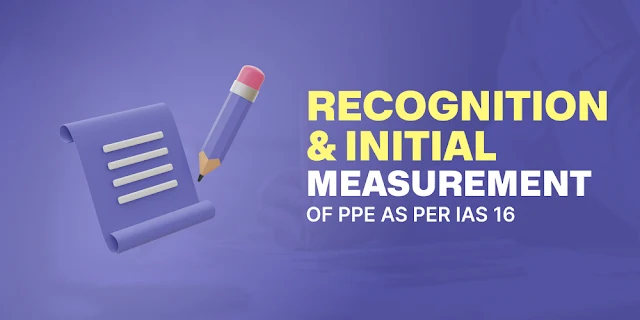Recognition and Initial Measurement of Property, Plant and Equipment (PPE) as per IAS 16
T ngible
fixed asset is a key resource for any business and generally represents a
significant portion of the net worth captured on the balance sheet. These fixed
assets help businesses to run its operating activities and thereby generating
revenue. Apart from generating future economic benefits, amount of such
tangible assets is also used in various vital ratios which are regularly
analysed by the users of financial statements. IAS 16 -“Property, Plant, and
Equipment” (PPE), is a basic and vital International Financial Reporting
Standard (IFRS) that provides guidelines on the accounting of tangible fixed
assets. IAS 16 provides the accounting principles for recognition, initial and
subsequent measurement, presentation, derecognition and disclosure for the PPE
in the financial statements.
In
essence, IAS 16 provides in depth guidance on the topics like when to recognise
PPE in the financial statements, how to measure asset initially i.e.
measurement basis (viz. cost), which expenses incurred will form part of the
cost of an asset (for e.g. borrowing costs, dismantling and restoration
expenses, directly attributable costs etc.), how to measure assets on
subsequent reporting date, i.e. measurement basis (cost or revaluation model),
how to determine the asset’s useful life, depreciation methods, impairment of
assets etc., where to present such assets in financial statements, when to
derecognise and which disclosures are required in the financial statements.
For
students pursuing a Diploma in
IFRS, having in depth knowledge on IAS 16 is fundamental. This
standard forms the backbone for accounting of tangible asset in the financial
reporting and helps in better analysing the financial statements of any entity.
It is vital for ensuring accurate and reliable financial reporting, which in
turn enhances the credibility of an entity’s financial statements.
Considering the fact that the topic is vast, in
this blog, we will discuss about recognition and initial measurement principle
of PPE as per IAS 16.
Definition of PPE:
– Ind
AS 16 defines property, plant and equipment as:
*Land or building or part
of land or building held for rental or for capital appreciation or for both
will be classified as investment property under Ind AS 40.
Bearer
plants also are considered as PPE as per IAS 16. Bear plants are the plants
which bear produce and plant itself will not be harvested as produce. For. e.g.
mango trees bear mangoes for more than one year and tree itself will not be
harvested as produce and thus mango tree can be classified as PPE.
Recognition Principle
To recognise Property, Plant & Equipment, all
the below conditions must be satisfied:
Recognise PPE – Generally this coincides with
physical delivery
Initial Measurement of Property,
Plant and Equipment
All PPE shall be measured
initially at ‘COST’.
Which expenses will form part of
costs will depend on the mode of its acquisition i.e.
- Separate
acquisition,
- Internally
generated
- In
exchange of another non-monetary asset
- In
business combination
- Government
grant (covered separately in IAS 20)
- Leases (covered
separately in IFRS 16)
Following is the summary of
expenses that will form part of the cost of PPE based on its mode of
acquisition.
01.
External acquisition
- Purchase price
- Import duties and non-refundable taxes
- All directly attributable expenditure
(viz. transportation, site preparation, installation, transit insurance
etc.)
- Borrowing costs (as per Ind AS 23)
- Dismantling and restoration costs
Deductions
from costs:
- Discounts and rebates
- Imputed cost of interest in case of
deferred credit arrangement
02
Self-constructed
- Direct material + non-refundable taxes
- Direct labour (ignore abnormal losses)
- Direct Overheads (ignore indirect
overheads)
- All directly attributable expenditure
- Borrowing costs (as per Ind AS 23)
- Dismantling and restoration costs
Deductions
from costs:
- Discounts rebates
- Imputed cost of interest in case of
deferred credit arrangement
Examples of costs that are not directly
attributable: training costs, costs of opening a new facility, costs of
conducting business from new territory, administration and general overheads.
03
Business combination
COST =
Acquisition date Fair Value
Recognition is
possible since:
- “Probability” criteria is assumed to be
satisfied and
- “Reliable measurement of cost” criteria
is satisfied if fair value can be measured reliably.
- Identifiable IA, even if not recognised
in the books of acquiree, are recognised separately from goodwill.
- If not identifiable, amount is subsumed
in goodwill.
04
Asset exchange
* Transaction shall not lack commercial substance
COST = Fair Value (of an asset which is more reliably measurable),
Sequence to determine
cost:
- Fair value of an outgoing asset (if FV
of both the assets are measurable with equal reliability)
- Fair value of an incoming asset (if fair
value of outgoing asset cannot be measured reliably)
- Carrying value of an outgoing asset (if
fair value of both the assets is not measurable reliably or transaction
lacks commercial substance)
At FinPro
Consulting, we focus on providing training, GAAP
conversion services, and other consulting support for financial reporting under
IFRS, Ind AS, and US GAAP. We are also a Registered Learning Partner (RLP) with
ACCA, UK, and have successfully conducted over 30 retail training sessions for
the Online DipIFR course.




Comments
Post a Comment